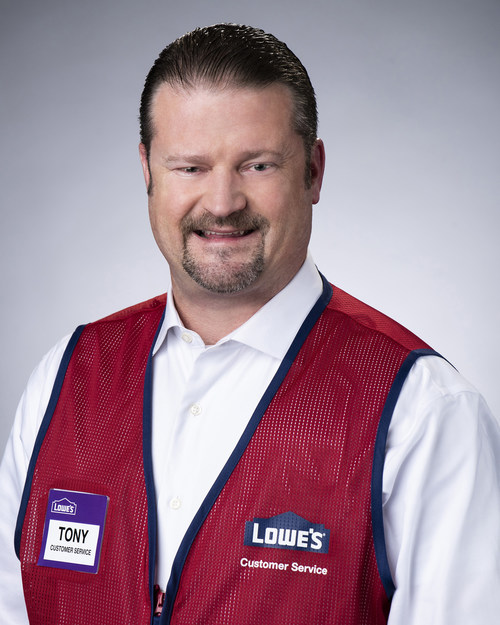June 10, 2021

In the early months of the Covid-19 pandemic lockdowns, one retail category in particular emerged victorious: the home improvement store.
As people’s homes became more than just homes – they became de-facto offices, daycares, and schools – more shoppers began focusing on home projects and needed the supplies and expert advice to make their DIY dreams come true. And Lowe’s Canada was there to meet those needs head-on.
“Our paint business was actually the strongest out of the gate,” laughs Tony Hurst, CEO of Lowe’s Canada. “We think it’s because people were just sitting at home, staring at their blank walls, and suddenly wanted a change.”
All joking aside – Hurst, who has an impressive retail resume spanning decades across The Home Depot, JC Penney, and Lowe’s, recently sat down with the Retail Council of Canada to discuss his experience sitting at the helm of Lowe’s Canadian business during such a tumultuous time. From infrastructure upgrades to assortment expansion, Hurst’s impressive list of accomplishments has given him excellent perspective on what’s in store for retailers in the future.
Here’s some of his advice for retailers looking to excel post-Covid and beyond:
One trend coming out of the pandemic that’s sure to stick around is the importance of online capabilities. “All retailers had to execute against true omni-channel strategies, and with the complexity of our particular business model in Canada, we had some catching up to do,” says Hurst. “We worked very hard to harmonize our different websites and IT capabilities to give a great experience to the customer.”
But Hurst strongly believes that focusing on digital capabilities and assortment only makes up half of the equation: “You can have a great online business and great products, but in this ‘curbside’ environment you have to invest heavily in store execution and operational efficiencies. That’s how you take care of your customers.”
For Lowe’s Canada, investing in store-level capabilities looked like the installation of pick-up lockers so customers could have frictionless access to purchases on the sales floor, as well as new technology that helped stores get orders in a timely manner (“It used to take about seven hours from the time an order was placed to the time it was executed on; now we’ve got that down to under thirty minutes,” Hurst explains.)
All retailers experienced a dearth of in-store foot traffic during the pandemic, and as more shoppers become accustomed to online shopping and curbside pickup, many are bracing themselves for a lower number of brick and mortar visitors overall. But Hurst doesn’t think that trend will hold true for Lowe’s: “In our business, customers want to touch and feel things, see colors, be inspired,” he explains. “By coming into a store, looking at sets, being able to talk to somebody who is an expert and who can give advice… that makes us relevant.”
When asked how Lowe’s might provide better customer service in stores, Hurst’s answer was simple: “We need to give our associates more time to serve our customers.” One way to do that is by eliminating time-consuming, administrative tasks that can be easily automated or streamlined using technology.
For example, Lowe’s Canada recently rolled out digital price signage in their lumber and appliances departments, with plans to roll to more departments soon. Customers can see an item’s price, features and benefits all at once, and Lowe’s has the ability to be more reactive to competitive price changes. But most importantly? “Our people don’t have to physically print and change a sign every time,” says Hurst. The time saved can be directly funneled back into more valuable face-to-face conversations with customers.
Making the most of every customer interaction is more important than ever in a post-Covid shopping environment. “People are making their trips [to Lowe’s] very purposeful to make it a ‘one-stop’ trip,” Hurst explains. “People are making sure they aren’t just cherry-picking items for a particular project.” Properly displayed merchandise and visual set-ups that “flow” can help customers find what they need, faster. “We have invested a lot this year in our ability to better merchandise for our customers and give them more choices,” says Hurst.
Lowe’s Canadian business is unique in that it relies on several vendors and suppliers to keep their shelves stocked, “and nobody knows the product better than the supplier,” says Hurst. That’s why he encouraged all suppliers to make product knowledge more robust and accessible. “We want to train our associates and give them product knowledge and confidence to sell to our customers,” explains Hurst. “I believe suppliers should help us get this messaging down to hourly associates.”
Hurst cites a particular success story with a Canadian cabinet supplier who was a tremendous partner in training. “They invested heavily in helping our associates understand the features and benefits of their product, and in return we helped grow their business across the country,” he explains. “They have a great product, but I believe it’s the way they empowered our associates that ensured their success.”
When asked how his leadership style changed during the pandemic, Tony’s response: “I don’t know that anything has necessarily changed, but I think we have reprioritized. We’ve put more emphasis on how we recognize our people.”
At the onset of Covid-19, Lowe’s Canada was quick to reward frontline workers financially through bonuses, pay increases, and extended paid time off benefits. The company also instituted a “Winning Together” program, through which associates are able to share in the company’s overall financial success. “I think that’s very, very important,” says Hurst. Lowe’s Canada also reprioritized by focusing more on being a good corporate steward within the communities they serve. “We know we need to be invested in supporting the communities our associates live in,” says Hurst.
“As somebody who started their career in retail as a cashier, I understand first-hand how important it is to have connectivity to leadership on issues that concern you,” says Hurst. “I’m proud to say that the Lowe’s Canada Leadership Team were side-by-side with our frontline associates, getting into stores, helping fulfill orders, and showing our employees that we were doing everything possible to keep them and our customers safe.”
At Zipline, we believe that associates are the “unlock” to delivering the best customer experience in store. We know they are also the most difficult to reach and engage. Fortunately, Zipline is built to address specific needs of this part-time audience, with a product called the Associate Experience.
The Associate Experience brings a focused and actionable view of Zipline to frontline employees (who may or may not work a few short shifts a week, and who may or may not have access to store email!). The Associate Experience helps engage and inform Associates while continuing to streamline communication and improve store execution. It brings together the needs of HQ to share the brand voice/vision to teams, with the needs of Store Managers to have a better way to work with their team.
If you’d like to see a demo of this product to learn how you can unlock the power of your frontline workforce, please reach out!
Recent Posts
Company News
Zippy is Officially Here!
Employee Engagement
NRF 2025 Day 3 Insights
Industry Trends
NRF 2025 Day 2 Insights
Industry Trends
NRF 2025 Day 1 Insights
Industry Trends
NRF 2025 is your best NRF yet!
Company News
Your ultimate fantasy retail team: Zipline, Legion, RetailNext
Company News
Meet the Retail Rockstars at NRF 2025: Learn, Network, and Get Inspired
Company News
Lighting Up Times Square: A Love Letter to Store Employees
Company News
Zipline Named a Finalist for the NRF VIP Awards!
Retail Communications
How Visionworks Brought Comms into Focus with Creative Hubs
Retail Communications
How L.L.Bean Made Store Communication Awesome
